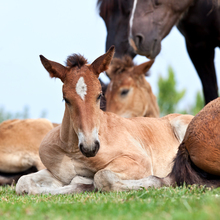Osteochondrosis (OC) is the most common developmental orthopaedic disease in horses and represents a major problem to the horse industry. The complete mechanism of this multifactorial disease is not yet known, but it is accepted that OC lesions are the result of intrinsic genetic and external factors.

Preventing OC lesions in foals
Study shows that keeping foals exclusively at pasture from birth to one year of age is a protective factor against osteochondrosis (OC) lesions in young sport horses.
In a study by Laurent Vander Heyden and others at the University of Liege, data was collected on housing and feeding management of 223 young Belgian warmbloods under field conditions. Radiological examinations were performed.
Feeding practice and housing management were analyzed in a multivariate model to determine risk factors for OC in three periods: gestation, birth to weaning and weaning to one-year-old.
Results of the study suggest that rearing factors have a significant impact on the prevalence of osteochondrosis lesions in young sport horses. Keeping foals exclusively at pasture from birth to one year of age is a protective factor against osteochondrosis (OC). This is the conclusion of a paper that was published in Veterinary Record.
The researchers found a significant relationship between OC development and the maternal nutrition during gestation and the type of housing of the foals during their first year. It appears that mares fed with concentrates during gestation are more likely to produce foals that are subsequently affected by OC compared with other mares.
Furthermore, foals housed exclusively at pasture until one year of age are significantly less affected than foals exclusively housed in box or, alternatively, in box and at pasture.
These results underline the role of the energy metabolism and the level of exercise in the aetiologic process of the disease, and help to develop preventive strategies
Veterinary Record January 2013
